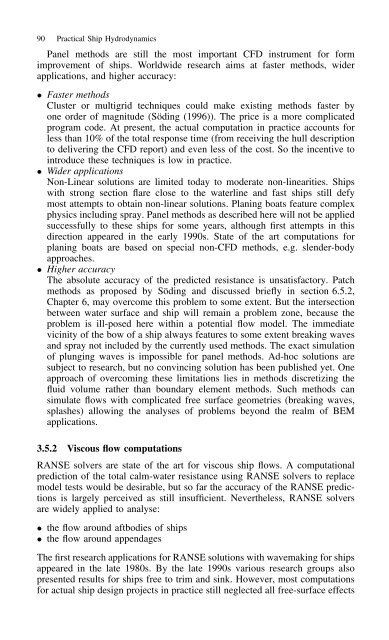Practical Ship Hydrodynamics
Practical Ship Hydrodynamics
Practical Ship Hydrodynamics
You also want an ePaper? Increase the reach of your titles
YUMPU automatically turns print PDFs into web optimized ePapers that Google loves.
90 <strong>Practical</strong> <strong>Ship</strong> <strong>Hydrodynamics</strong><br />
Panel methods are still the most important CFD instrument for form<br />
improvement of ships. Worldwide research aims at faster methods, wider<br />
applications, and higher accuracy:<br />
ž Faster methods<br />
Cluster or multigrid techniques could make existing methods faster by<br />
one order of magnitude (Söding (1996)). The price is a more complicated<br />
program code. At present, the actual computation in practice accounts for<br />
less than 10% of the total response time (from receiving the hull description<br />
to delivering the CFD report) and even less of the cost. So the incentive to<br />
introduce these techniques is low in practice.<br />
ž Wider applications<br />
Non-Linear solutions are limited today to moderate non-linearities. <strong>Ship</strong>s<br />
with strong section flare close to the waterline and fast ships still defy<br />
most attempts to obtain non-linear solutions. Planing boats feature complex<br />
physics including spray. Panel methods as described here will not be applied<br />
successfully to these ships for some years, although first attempts in this<br />
direction appeared in the early 1990s. State of the art computations for<br />
planing boats are based on special non-CFD methods, e.g. slender-body<br />
approaches.<br />
ž Higher accuracy<br />
The absolute accuracy of the predicted resistance is unsatisfactory. Patch<br />
methods as proposed by Söding and discussed briefly in section 6.5.2,<br />
Chapter 6, may overcome this problem to some extent. But the intersection<br />
between water surface and ship will remain a problem zone, because the<br />
problem is ill-posed here within a potential flow model. The immediate<br />
vicinity of the bow of a ship always features to some extent breaking waves<br />
and spray not included by the currently used methods. The exact simulation<br />
of plunging waves is impossible for panel methods. Ad-hoc solutions are<br />
subject to research, but no convincing solution has been published yet. One<br />
approach of overcoming these limitations lies in methods discretizing the<br />
fluid volume rather than boundary element methods. Such methods can<br />
simulate flows with complicated free surface geometries (breaking waves,<br />
splashes) allowing the analyses of problems beyond the realm of BEM<br />
applications.<br />
3.5.2 Viscous flow computations<br />
RANSE solvers are state of the art for viscous ship flows. A computational<br />
prediction of the total calm-water resistance using RANSE solvers to replace<br />
model tests would be desirable, but so far the accuracy of the RANSE predictions<br />
is largely perceived as still insufficient. Nevertheless, RANSE solvers<br />
are widely applied to analyse:<br />
ž the flow around aftbodies of ships<br />
ž the flow around appendages<br />
The first research applications for RANSE solutions with wavemaking for ships<br />
appeared in the late 1980s. By the late 1990s various research groups also<br />
presented results for ships free to trim and sink. However, most computations<br />
for actual ship design projects in practice still neglected all free-surface effects
















